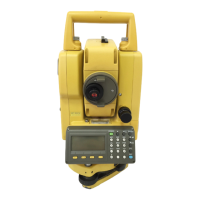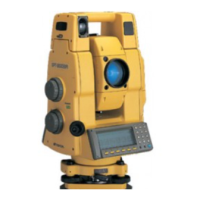
Do you have a question about the Topcon GPT-3003W and is the answer not in the manual?
| Brand | Topcon |
|---|---|
| Model | GPT-3003W |
| Category | Measuring Instruments |
| Language | English |
Information on the invisible laser beam used for distance measurement.
Safety guidelines for visible laser beams used in laser pointers and plumb lasers.
Identifies and labels the various parts of the instrument.
Instructions for connecting the instrument's power source.
Procedures for leveling and centering the instrument on a tripod.
Steps to power on the instrument after leveling.
How to enable and use tilt sensors for angle correction.
Step-by-step guide for measuring horizontal and vertical angles.
How to input atmospheric data for accurate distance measurements.
Adjusting constants for prism or non-prism targets.
Performing continuous distance measurements.
Guiding points for stake-out operations.
Measuring points offset from a known line or plane.
Inputting the instrument's location coordinates.
Entering the height of the instrument above the tribrach.
Entering the height of the prism or target.
Performing measurements to determine unknown point coordinates.
Accessing special measurement programs.
Measuring the elevation of a point without direct sighting.
Calculating distances between unseen points.
Enabling/disabling tilt correction for angle measurements.
Initial steps before starting data collection.
Choosing or creating a file to store collected data.
Setting the instrument's occupied point and backsight direction.
Detailed steps for executing the data collection process.
Performing offset measurements for inaccessible points.
Automatic calculation and storage of NEZ coordinates.
Measuring offset points relative to a defined line.
Configuring settings for data collection operations.
Initial setup steps for layout operations.
Defining the instrument's occupied point.
Performing the layout process using specified points.
Inputting temperature and pressure for correction.
Instructions for removing, charging, and refreshing the battery.
Step-by-step guide for configuring various instrument modes.
Verifying and setting the instrument's constant values.
Ensuring alignment of optical axes for EDM, theodolite, and laser pointer.
Procedures to check and align EDM and theodolite optical axes.
Procedures for checking and adjusting theodolite functions.
Inputting the instrument's constant values.











